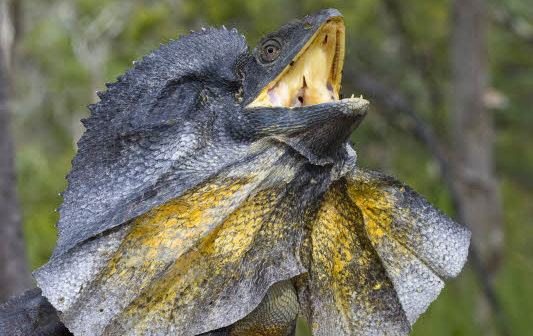Behaviour
Diet
Mainly invertebrates, including insects and spiders, but will occasionally eat small vertebrates, including mammals and other lizards. It especially likes green ants.
Movement
Active during the day, particularly during the wet season. It basks in the morning sun to raise its body temperature and give it energy to feed and run quickly for the remainder of the day. It mainly forages for food in the morning and late afternoon and spends the rest of its time on tree trunks and limbs. Its long slim front limbs and strong hind legs enable it to stretch and move easily between branches. It scans the ground for prey from the trees then rapidly descends and runs on two legs along the ground, before dropping onto four legs to seize its prey.
If threatened, it will sit back on its hind legs and open its mouth to expand its frill. It then hisses and may jump towards the predator. If that has no effect, it will turn quickly and run away on two legs to climb the nearest tree and hide behind the trunk or a branch.
Breeding
Begins at the start of the wet season (spring). Males are very territorial and aggressive toward other males during this time. They court females by performing an elaborate dance. If a female is interested she bobs her head. Mating occurs around September after which the female lays between 8 and 14 (sometimes up to 23!) eggs in a nest 10 – 20 cm deep in the ground, usually after rain. The eggs hatch after 8 – 12 weeks and the hatchlings are completely independent, remaining together for up to 10 days in the absence of any parental care. There may be two clutches per season, depending on the availability of food and other resources.
Field Guide
Improve your identification skills. Download your Frill-necked Lizard guide here!





